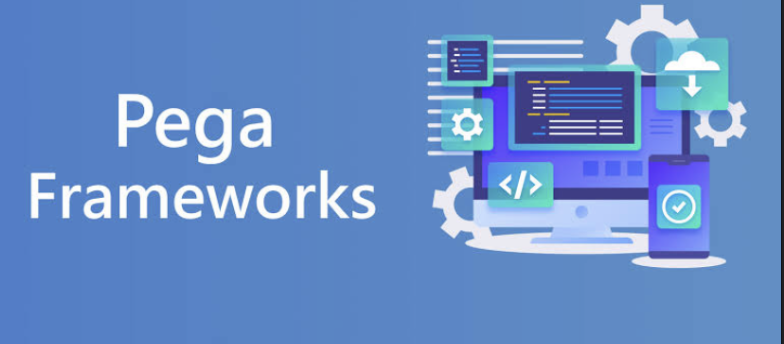Pega is a highly scalable software that stands for Process based Enterprise application and is built for the purpose of defining business processes and automating them.
Top organisations like Deloitte, Cognizant, Accenture, TCS use Pega Frameworks to deliver their projects rapidly.
There are always the Pega frameworks that make up a large part of the Pega software, giving developers templates to follow and tools to use.
What Are Pega Frameworks?
Pega frameworks are industry and business function-specific, out-of-the-box configurations designed to meet the required needs. Let’s learn more about Pega frameworks with Pega Training. These frameworks consist of incorporated procedures, regulations, and records that can be modified to meet the firm’s specific needs. Online learning by Blackboards can be enhanced with Pega FrameWorks to create personalized and interactive learning experiences for students. These frameworks help organizations reap a great benefit in terms of start-up times, effort, etc., which enhance their digital transformation process.
Types of Pega Frameworks
There are numerous frameworks by Pega, but these frameworks are specific to various business issues. Here are some of the most popular ones:
1. Customer Service: This framework is centered on improving customer engagement through different contact points and offering the agents proper solutions. It can be easily blended with current customer relationship management (CRM) solutions to provide a consolidated customer picture.
2. Marketing: Pega’s marketing framework can be used by a company to develop appropriate targeted marketing strategies and programs, monitor customers’ reactions to such programs and make adjustments. CBSE career guidance platforms can leverage Pega FrameWorks to create personalized career paths and provide tailored recommendations for students. It uses data analysis to reach the intended customer with the correct message at the right time, improving the end results.
3. Sales Automation: This framework eliminates the time and energy-consuming activities, makes the entire sales process faster and enables the organization to close deals at the right time. It assists sales organizations in creating forecasts of revenues and handling opportunities and production of sales.
4. KYC (Know Your Customer): Crucial for the financial sector, this structure provides regulatory compliance by effectively automating the checks of customers. They include: It assists an organization in minimizing risk, avoiding fraud, and having updated customer data.
5. Financial Services: Designed for banking industries, this framework enables a number of services such as loan services, account services and security and fraud services. It makes financial activities easier to manage, thus improving organizational efficiency and customer satisfaction.
6. Healthcare: Pega’s healthcare framework helps in handling patient and administrative operations and fulfilling the regulatory requirements. Regarding patients, it facilitates registration, appointment booking, and insurance claims so that healthcare givers can devote their time to healthcare delivery.
7. Insurance: This framework aids insurance industries in balancing the issues related to polishing, underwriting, and customer relations services. It provides addressing of underwriting and claims, then eliminates manual work, shortens the time taken and increases efficiency.
Benefits of using Pega frameworks
1. Speed and Efficiency: The use of pre-built components is, therefore, a great advantage for organizations as applications can then be developed and deployed much quicker than when developing them from the ground up. This rapid development cycle can help businesses to be agile in satisfying customer needs and adapting to market shifts.
2. Reduced Costs: The time taken to develop a new product means a lot of expenditure hence the importance of saving time. Also, there is a decreased probability of some mistakes because all components that are used are proven, which ultimately reduces rework and testing time.
3. Scalability: Pega frameworks integrate well in organizations to address large data management and transactional requirements characteristic of growing enterprises. They can accommodate growing user traffic and transactions as and when the need arises without exhibiting poor results.
4. Flexibility: It is important to understand that although Pega frameworks come with pre-settings, they are fully adaptable. Companies are able to adapt the conceptual frameworks to deal with their particular procedures or any other business specifics and, in this way, reach an ideal fit of the intended final solution.
5. Compliance: Such operational frameworks as KYC help businesses to remain in legal bounds; hence, a business will not afford to engage in a legal battle. They come compliant with internal control and audit trails that can assist organizations in showing compliance to the regulators.
6. Improved Customer Experience: Pega frameworks are developed with the end user in mind The tables below have been developed under a four meant structure. They have interactive front ends, and CRM is built to give users a more pleasant experience they are likely to stick to the brands they use.
Read: How Many Versions of Your CV Do You Need?
Main Characteristics of Pega Frameworks
1. Case Management: Pega frameworks employ case management, and all business processes are managed as cases. This can help track and manage previously difficult tasks and activities. Frequently, cases can be many-folded and would require several sub-steps and/or interaction with many individuals. At the same time, at other times, they can be single-step and require interaction with only one person.
2. Decision Management: Pega also offers effective decision management capabilities that use AI and machine learning to make decisions for insight. These tools assist various organizations in optimizing decision-making and guarantee that the procedures are standard and precise.
3. User Interface: The frameworks are accompanied by easy-to-use GUIs that make it easy for users to interact with them and increase efficiency. The interfaces are planned to be available on computers, tablets, and smartphones, as well as other viewers.
4. Integration: The design of Pega frameworks allows it to be extensible and incorporate other systems and databases in its environment. They are compatible with many integration protocols and standards and can combine new and old IT systems.
5. Reporting and Analytics: Reporting and analysis options are integrated into the solution and are beneficial for the evaluation of the business’s performance. Some of these tools have features such as an intervention dashboard, real-time reports, and even analytical tools.
6. Automation: Pega frameworks incorporate some of the features of robotic process automation (RPA) to support the digitization of repetitive tasks. This helps reduce the workload of the employees, eliminates redundancy, and ensures that employees use time well.
7. Security: The frameworks that Pega provides have rather strong security aspects totaling role-based access control, data encryption, and audit logging. These features provide security to the application and make sure that no one but authorized people can see it.
Implementation of Pega Frameworks
Implementing Pega frameworks involves several steps:
1. Assessment: Review your organization’s requirements and determine where Pega frameworks can benefit your company most. This relates to the processes that you currently carry out, the challenges that you meet, and the objectives you have for your business.
2. Selection: Select the appropriate Pega framework(s) based on the obtained results of the risk assessment. Evaluate criteria like, the extent to which it meets the needs of the organization, expandability, and integration with current infrastructure.
3. Customization: Adjust the observed framework to the needs of your business and the existing work processes. It may therefore include customization on how workflows, rules and the end user interfaces are on the operational aspects.
4. Integration: Available today in an expression that is fully compatible with your existing solutions and databases. This makes it possible for data to be passed from Pega to other applications so that process integration can be achieved.
5. Testing: Make sure to do a lot of testing on the customized framework to check how well it performs a function. These are the functional test, the performance test, and the user acceptance test.
6. Deployment: Implement the materials learned during the course in your production environment. This means that the organization should be prepared for the new system and confirm that every required facility is put in place and users are willing to embrace a change.
7. Training: Make your team aware of the efficiencies of the new system so that they can operate it the right way. Offer detailed training, handbooks, and support for the change to minimize problems.
8. Monitoring: Oversee the system to ensure it is running optimally and to identify the need for some changes. Organizations should monitor the application usage to ascertain areas of a problem and subsequently make suitable modifications with the help of the built-in analytics and reporting systems.
Future of Pega Frameworks
Pega, year after year, fine-tunes its frameworks as technologies change and new opportunities appear. Future developments may include:
1. Enhanced AI Capabilities: Improved capability and flexibility of the more substantial AI and machine learning application to improve decision-making results. This could be statistical analysis, speech recognition, and robotic process automation.
2. Better Integration: Enhanced connectivity features with some of the modern technologies like IoT and blockchain. Thus, new types of data would be utilized and the automation of processes would be further advanced.
3. Increased Customization: Even more flexibility in the anatomy of the identified frameworks from the proposed point of view to meet business needs. This could include direct managing for specificities like Workflow, rules and different interfaces.
4. Cloud Adoption: More focus on cloud-based platforms to accommodate a larger array and make it easier to use the services. Pega may provide stronger cloud usage options for deployment, which will help business organizations implement a cloud-based computing environment.
5. User Experience: A recurring theme would be the improvement of the graphical user interface so that it becomes even more friendly and ergo-non-complex to navigate. This might encompass such aspects as modern design trends, mobile-first approach, and improved access arrangements.
6. Sustainability: Pega frameworks may include components that can address sustainability, for example, energy-efficient solutions, minimization of waste, and adherence to statutes on the environment.
7. Collaboration Tools: Increased productivity, especially because the collaborative features allow members of a team to work effortlessly. This may involve working in a single environment, such as media embedded with communication features or improved project management functionalities.
Conclusion
Pega frameworks are effective weapons that can change many business processes in companies. For this reason, Pega offers pre-built, industry-specific solutions that organizations can easily configure to their specific requirements, which in turn, enhances their business operation and cuts down on expenses.
Since Pega will globally include new frameworks with the one it currently offers, the probability of these frameworks being beneficial to business will just increase in the future.
To gain its maximum benefits, it is crucial to comprehend and utilize the Pega framework as a game-changer for any organization trying to survive in today’s dynamic business sector. Navigating principal burnout can be eased by leveraging Pega FrameWorks to automate routine tasks and streamline workflows, allowing educators to focus on strategic initiatives.
So, no matter whether you’re with a customer service team, marketing, a sales team, finance, or a healthcare organization, there could be a solution for you in the Pega framework to help you achieve your company objectives.




